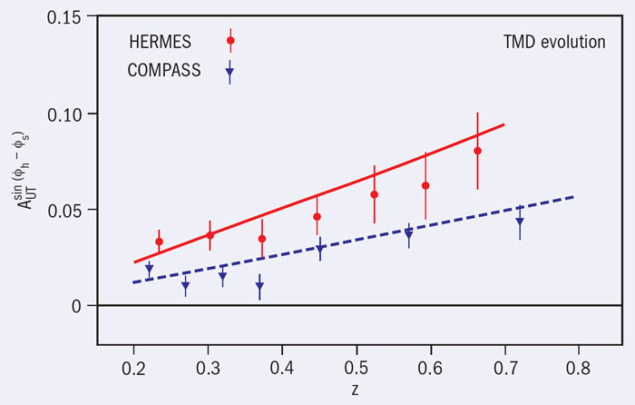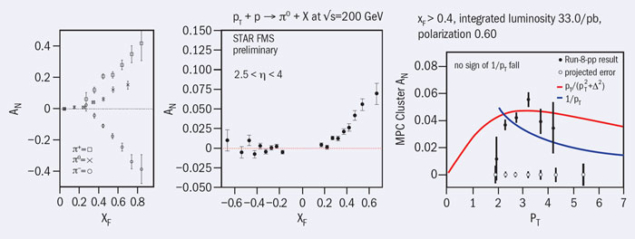A report from the biennial international spin symposium.
SPIN 2012, the 20th International Symposium on Spin Physics, took place at the Joint Institute for Nuclear Research (JINR) in Dubna on 17–22 September. Around 300 participants attended from JINR and institutes in 22 countries (mainly Germany, Italy, Japan, Russia and the US). It consisted of a traditional mix of plenary and parallel sessions. Presentations covered the spin structure of hadrons, spin effects in reactions with lepton and hadron beams, spin physics beyond the Standard Model and future experiments, as well as the techniques of polarized beams and targets, and the application of spin phenomena in medicine and technology.

The symposium began with a focus on work at Dubna, starting with the unveiling of a monument to Vladimir Veksler, who invented the principle of phase stability (independently from Edwin McMillan in the US) and founded the 10 GeV Synchro-phasotron in Dubna in 1955. Talks followed about the future projects to be carried out at JINR’s newest facility, the Nuclotron-based Ion Collider fAcility (NICA). The complex will include an upgraded superconducting synchrotron, Nuclotron-M, with an area for fixed-target experiments, as well as a collider with two intersections for polarized protons (at 12 GeV per beam) or deuterons and nuclei (5 A GeV per beam). It will provide opportunities for a range of polarization studies to complement global data and will particularly help to solve the puzzles of spin effects that have been awaiting solutions since the 1970s. The spin community at the symposium supported the plans for these unique capabilities, and JINR’s director, Victor Matveev, announced that the project is ready to invite international nominations for leading positions in the spin programme at NICA.
The experimental landscape
In the US, Jefferson Lab’s programme of experiments on generalized parton distributions (GPDs) will be implemented with upgraded detectors and an increase in the energy of the Continuous Electron Beam Accelerator Facility from 6 GeV up to 12 GeV. The laboratory is also considering the construction of a new synchrotron to accelerate protons and nuclei up to 250 GeV before collision with 12 GeV electrons. In a similar way, a new 10–30 GeV electron accelerator is being proposed at Brookhaven National Laboratory to provide collisions between electrons and polarized protons and ions, including polarized 3He nuclei, at the Relativistic Heavy-Ion Collider (RHIC). The aim will be to investigate the spin structure of the proton and the neutron.

At CERN, the COMPASS-II project has been approved, firstly to study Drell-Yan muon-pair production in collisions of pions with polarized nucleons, to investigate the nucleon’s parton distribution functions (PDFs). A second aim is to study GPDs via the deeply virtual Compton-scattering processes of exclusive photon and meson production. The latter processes will provide the possibility for measuring the contribution of the orbital angular momenta of quarks and gluons to the nucleon spin. The Institute of High Energy Physics (IHEP), Protvino, has a programme at the U-70 accelerator for obtaining polarized proton and antiproton beams from Λ decay for spin studies at the SPASCHARM facility, which is currently under construction.
The participants heard with interest the plans to construct dedicated facilities for determining the electric dipole moment (EDM) of the proton and nuclei, with proposals by the Storage Ring EDM collaboration at Brookhaven and the JEDI collaboration at Jülich. The dipole moment of fundamental particles violates both parity and time-reversal invariance. Its detection would indicate the violation of the Standard Model and would, in particular, make it possible to approach the problem of understanding the baryon asymmetry of the universe. The proposed experiments would reduce the measurement limit on the deuteron EDM down to 10–29 e cm.
Classical experiments studying the nucleon spin structure at high energies use both lepton scattering on polarized nucleons (e.g. in HERMES at DESY, COMPASS and at Jefferson Lab) and collisions of polarized hadrons (at RHIC, IHEP and JINR). A unified description of these different high-energy processes is becoming possible within the context of QCD, the theory of strong interactions. Related properties, such as factorization, local quark–hadron duality and asymptotic freedom, allow the calculation of the characteristics of the process within the framework of perturbation theory. At the same time, PDFs, correlation and fragmentation functions are not calculable in perturbative QCD, but being universal they should be either parameterized and determined using various processes or calculated within some model approaches. A number of talks at the symposium were devoted to the development and application of such models.
Theory confronts experiment
Experiments involving spin have brought about the demise of more theories than any other single physical parameter. Modern theoretical descriptions of spin-dependent PDFs, especially those including the internal transverse-parton motion, were discussed at the symposium. In this case, the number of PDFs increases and the picture that is related to them loses – to a considerable degree – the simplicity of a parton model with its probabilistic interpretation. One of the difficulties here concerns how the PDFs evolve with a change in the wavelength of the probe particle. A new approach to solving this problem was outlined and demonstrated for the so-called Sivers asymmetry measured in data from the HERMES and COMPASS experiments (figure 1).

The helicity distributions of the quarks in a nucleon are the most thoroughly studied so far. The results of the most accurate measurements by COMPASS, HERMES and the CLAS experiment at Jefferson Lab were presented by the collaborations. The present-day experimental data are sufficiently precise to include them in QCD analysis. Two new alternative methods for the QCD analysis of deep-inelastic scattering (DIS) and semi-inclusive DIS (SIDIS) data allow a positive polarization of strange quarks to be excluded with a high probability. As for the gluon polarization, the results of its direct measurement by the COMPASS experiment, which are confirmed by the PHENIX and STAR experiments at RHIC, also agree with QCD analysis. The low value of gluon polarization indicates that its contribution to nucleon spin is not enough to resolve the so-called nucleon-spin crisis. Hopes to overcome this crisis are now connected to the possible contributions of the orbital angular momenta of quarks and gluons, to be measured from GPDs. There were talks on different theoretical aspects of GPDs, as well as experimental aspects of their measurement, in the context of the HERMES, CLAS and COMPASS experiments.
Other important spin distribution functions manifest themselves in the lepton DIS off transversely polarized nucleons. The processes in which the polarization of only one particle (initial or final) is known are especially interesting. However, although relatively simple from the point of view of the experiment, they are complicated from the theoretical point of view (such complementarities frequently occur). These single-spin asymmetries are related to T-odd effects, i.e. they seemingly break invariance with respect to time reversal. However, it is a case of “effective breaking” – that is, it is not related to a true non-invariance of a fundamental interaction (here, the strong interaction, described by QCD) with respect to time reversal but to its simulation by the effects of re-scattering in the final or initial states. The single asymmetries have been studied by theorists for more than 20 years. These studies have received a fresh impetus in recent years in connection with new experimental data on single-spin asymmetries in the semi-inclusive electroproduction of hadrons off longitudinally and transversely polarized and unpolarized nucleons.
Reports from the COMPASS collaborations on transverse-momentum-dependent (TMD) asymmetries were one of the highlights of the symposium. The experiment is studying as many as 14 different TMD asymmetries. Two of them, the Collins and Sivers asymmetries (figure 2) – which are responsible for the left–right asymmetries of hadrons in the fragmentation of transversely polarized quarks and quark distributions in transversely polarized nucleons – are now definitely established in the global analysis of all of the available data, although other TMD effects require further study. The results of studies of the transverse structure of the proton at Jefferson Lab were also presented at the symposium.

The PHENIX and STAR collaborations have new data on the single-spin asymmetries of pions and η-mesons produced in proton–proton collisions at 200 GeV per beam at RHIC, with one of the beams polarized and the other unpolarized. They observe amazingly large asymmetries in the forward rapidity region of the fragmenting polarized or unpolarized protons, with a fall to zero in the central rapidity region. A similar effect was observed earlier at Protvino and at Fermilab, but at lower energies, thus confirming energy independence (figure 3). In addition, there is no fall with rising transverse momentum in the values of the asymmetry measured at RHIC. The particular mechanism for these asymmetries remains a puzzle so far.
So although single-spin asymmetries on the whole are described by existing theory, developments continue. The T-odd distribution functions involved lose the key property of universality and become “effective”, that is, dependent on the process in which they are observed. In particular, the most fundamental QCD prediction is the change of sign of the Sivers PDF determined from SIDIS processes and from Drell-Yan pair-production on a transversely polarized target. This prediction is to be checked by the COMPASS-II experiment as well as at RHIC, NICA and in the PANDA and PAX experiments at the Facility for Antiproton and Ion Research.
New data from Jefferson Lab on measurements of the ratio of the proton’s electric and magnetic form factors performed by the technique of recoil polarization gave rise to significant interest and discussions at the symposium. The previous measurements from Jefferson Lab showed that this ratio is not constant, as had been suggested for a long time, but decreases linearly with increasing momentum transfer, Q2 – the so-called “form factor crisis”. New data from the GEp(III) experiment indicate a flattening of this ratio in the region of Q2 = 6–8 GeV2. The question of whether this behaviour is a result of an incomplete calculation of radiative corrections – in particular, two-photon exchange – remains open.
The symposium enjoyed hearing the first results related to spin physics from experiments at CERN’s LHC. In particular, many discussions focused on the role of spin in investigating the recently discovered particle with a mass of 125 GeV, which could be the Higgs boson, as well as in studies of the polarization of W and Z bosons, and in heavy-quark physics. A number of talks were dedicated to the opportunities for theory related to searches for the Z’ and other exotics at the LHC and the future electron–positron International Linear Collider.
On the technical side there was confirmation of the method of obtaining the proton-beam polarization at the COSY facility in Jülich by spin filtration in the polarized gas target. This method can also be used for polarization of an antiproton beam, which will be important for measurements of different spin distributions in the nucleon via Drell-Yan muon-pair production in polarized proton–antiproton collisions in the PANDA and PAX experiments. There were also discussions on sources of polarized particles, the physics of polarized-beam acceleration, polarimeters and polarized-target techniques. In addition, there were reports on applications of hyperpolarized 3He and 19F in different fields of physics, applied science and medicine.
The main results of the symposium were summarized in an excellent concluding talk by Franco Bradamante from Trieste. The proceedings will be published in special volumes of Physics of Elementary Particles and Atomic Nuclei. The International Committee on Spin Physics, which met during the symposium, emphasized the excellent organization and success of the meeting in Dubna and decided that the 21st Symposium of Spin Physics will take place in Beijing in September 2014.








